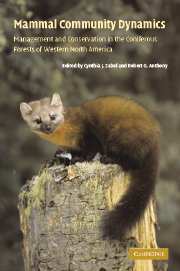 Mammal Community Dynamics
Mammal Community Dynamics Published online by Cambridge University Press: 15 December 2009
Introduction
Arboreal rodents were selected as a focal group because of their obvious association with forest canopies and relevance to forest management. The close association of arboreal rodents with trees predisposes them to being impacted by timber harvests (Carey 1989, Aubry et al. 2003, Hallett et al. 2003). Trees provide food, thermal and escape cover, shade, moisture and free water, and cavities that provide nest sites and safe refugia from avian and mammalian predators (Carey 1989, Carey et al. 1999, Aubry 2003). Carey (1989) characterized arboreal rodents according to their degree of dependence on trees for various activities and identified the following stand elements as important to their biology: large live trees, large snags, fallen trees, woody debris, multilayered canopy, overstory and understory diversity, and epiphytes. Additionally, he listed stand stability and landscape contiguity as important attributes with dense underbrush, streamsides, rock, and talus as special features (Carey 1989). More recent studies (e.g., Rosenberg and Anthony 1992, Waters and Zabel 1995, Smith and Nichols 2003) provide new information to examine the conclusions of Carey (1989), which serve as useful hypotheses regarding influences of forest management on arboreal rodent populations in western coniferous forests.
We selected species that are reputed late-seral forest habitat specialists or are known to be important prey for the northern spotted owl (Forsman et al. 2001, Hamer et al. 2001), the American marten (Buskirk and Ruggiero 1994, Ben-David et al. 1997), or the northern goshawk (Accipiter gentilis, Lewis 2001).
To save this book to your Kindle, first ensure [email protected] is added to your Approved Personal Document E-mail List under your Personal Document Settings on the Manage Your Content and Devices page of your Amazon account. Then enter the ‘name’ part of your Kindle email address below. Find out more about saving to your Kindle.
Note you can select to save to either the @free.kindle.com or @kindle.com variations. ‘@free.kindle.com’ emails are free but can only be saved to your device when it is connected to wi-fi. ‘@kindle.com’ emails can be delivered even when you are not connected to wi-fi, but note that service fees apply.
Find out more about the Kindle Personal Document Service.
To save content items to your account, please confirm that you agree to abide by our usage policies. If this is the first time you use this feature, you will be asked to authorise Cambridge Core to connect with your account. Find out more about saving content to Dropbox.
To save content items to your account, please confirm that you agree to abide by our usage policies. If this is the first time you use this feature, you will be asked to authorise Cambridge Core to connect with your account. Find out more about saving content to Google Drive.